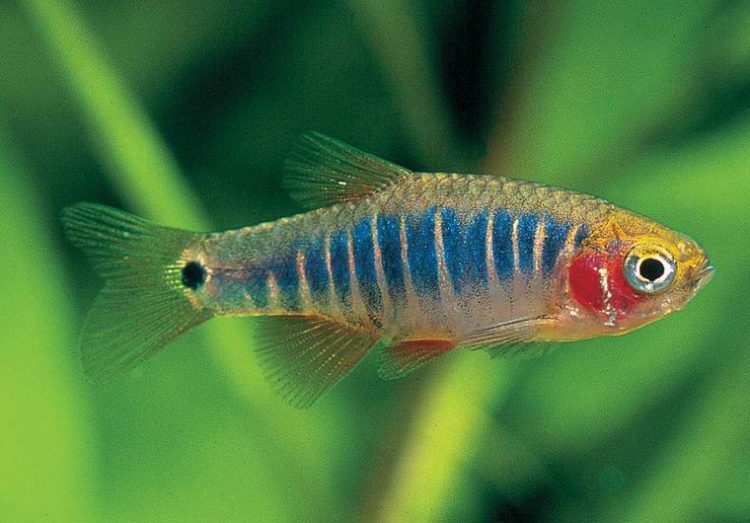This is a newly discovered fish from Myanmar in August, 2006. It has gotten a lot of attention in the aquarium trade and fish keepers around the globe. It has quite a few common trade names. They are sold under the Galaxy rasbora, Fireworks rasbora, Rasbora toei, Celestial pearl danio and of course the Microrasbora sp. “Galaxy”. However the scientific name is now known as Celestichthys margaritatus described by Tyson R. Roberts at Smithsonian Tropical Research institute in February, 2007. It belongs to the subfamily Danionae and family Cyprinidae.

The fish is collected from ponds in the Salween basin at an altitude over 3000 ft, about 70-80 km northeast of Inle Lake. It was first exported from Bangkok by Kamphol Udorithiruj of AquariCORP to the world of aquarists. It became a hit instantly because of its small size and beautiful color. The price was very high for such a small fish. However most stores cannot keep up with the demand. By February, 2007 there were rumors that the species is under threat due to over collecting. The fish was bred in captivity for the first time by Bolton Museum Aquarium in October, 2006.
I first bred them in January of 2007. I got 8 “Galaxy” rasbora from wild stock in November, 2006. They were skinny and had concave bellies. I guess they had been in transportation for a long time before they reached the retail store. I put them in a 10 gallon tank with bristle nose pleco babies with a few clumps of Java moss for them to feel comfortable in their new environment. Like most aquarists, I really did not have an empty tank at that time. I was going to set up a plant tank for them with intentions to breed them. I fed them with some flake food, frozen brine shrimp and live daphnia. I lost 2 of them in the first week probably due to the starvation during the shipping. The rest of them were eating well and starting to color up. They are very bright in color for such little fish. I could tell that there were 4 males and 2 females according to their appearance. The males have bright red fins with squiggles of blue-black in the dorsal and anal, and the upper lobes of the tail. Females are less colorful with less red and uncolored pelvic fins. The males are slimmer and the females are more rounded. They both have bright spots throughout their body. The biggest one is around 2.5 cm or 1 inch total body length. Within a month the males showed aggression by displaying their fins squaring off to each other. By this time I had not set up a dedicated tank for them yet.
On January 02, 2007 while I was feeding the fish, I saw some tiny fry moving on top of the aquarium. At first I thought I saw some killi fish fry hatching from the Java moss I took from another tank, which might have had some killifish spawning on it. I took a closer look and became very excited because I then realized that the Galaxy had been spawning in that tank and some fry had survived. The fry were quite small and colorless, like zebra danios or white cloud mountain minnow fry. They were about 3 mm long and had a slightly bigger head. I siphoned them out and put them in the cory cat babies tank. I started feeding them some green water and microworms. The fry need live micro organisms to feed on for the first a few days of their lives. After that they will eat tiny worms. The corys will clean up the leftover food. I tested the water from the adults Galaxy tank. The PH was 7.3, temperature was 22C and the hardness was 150 part per million. So they can breed in Edmonton water.
Every day I saw more fry in the adult tank. The male often displays posturing along side the female at the Java moss. According to the number of fry I think they only lay a few eggs each time they spawned. Every two or three days I siphoned some fry out and raised them separate from the parents. The adults might eat the fry if given a chance. The fry grow very slowly for the first few weeks. They grow at a much faster rate after 3-4 weeks. By this time I introduced baby brine shrimp to them. They do not develop the color pattern until 11-12 weeks old. Now they are about 1.2 cm long and 2 mm wide. I have around 50-60 fry in two 5 gallons tank with some cory babies with them. I stopped siphoning the fry from the adult tank as I am running out of tank space. I saw some fry that survived with the parents and are growing up. There are newly hatched fry in there with them too.
In conclusion, the Galaxy rasbora, C. margaritatus is a beautiful fish to keep and easy to breed. They are small but very active, peaceful and colorful for small planted aquariums. The price for them is getting cheaper now. My prediction is that in the next few months the captive bred ones will be available for aquarists around the world. I think the commercial fish farms in Asia are working at it right at this moment. If you are going to the next Edmonton club meeting or auction you might run into a bag or two of my captive bred Microrasbora sp. “Galaxy”.
Leave a Reply